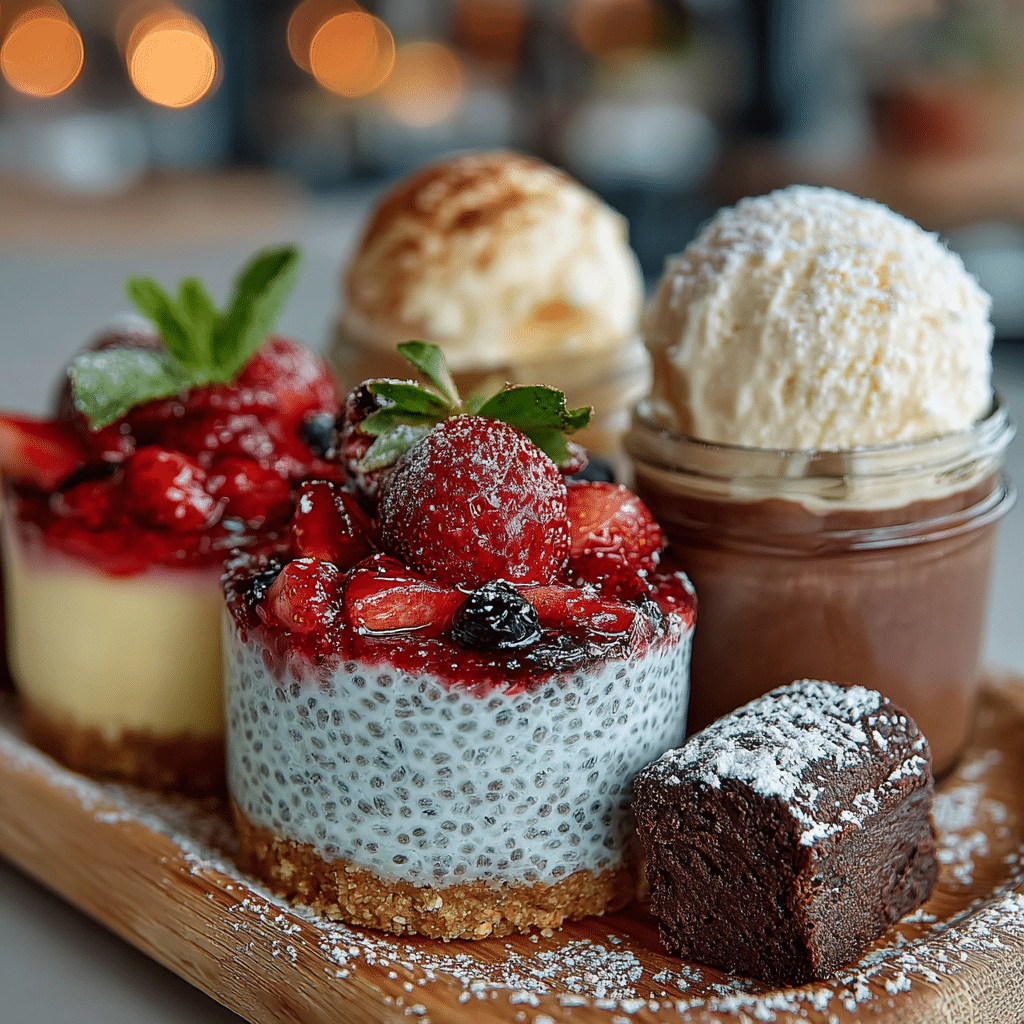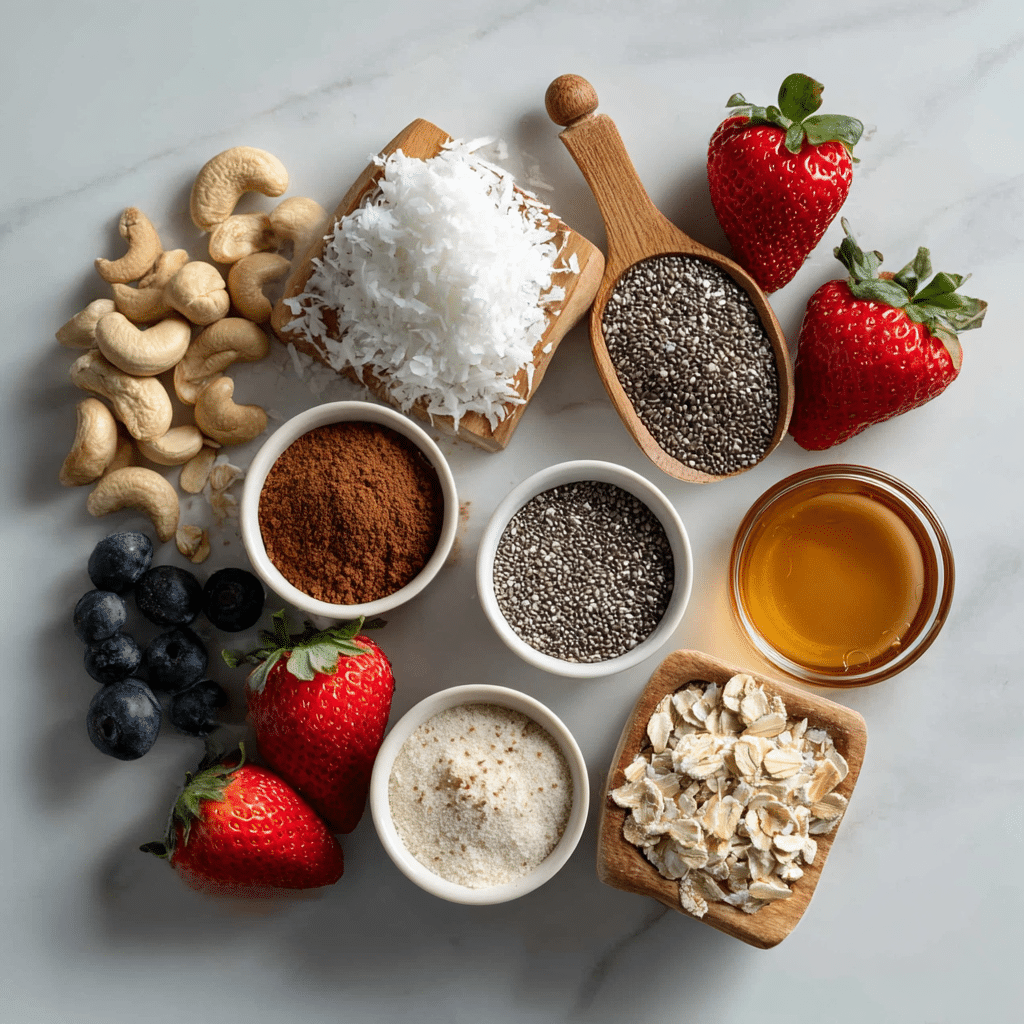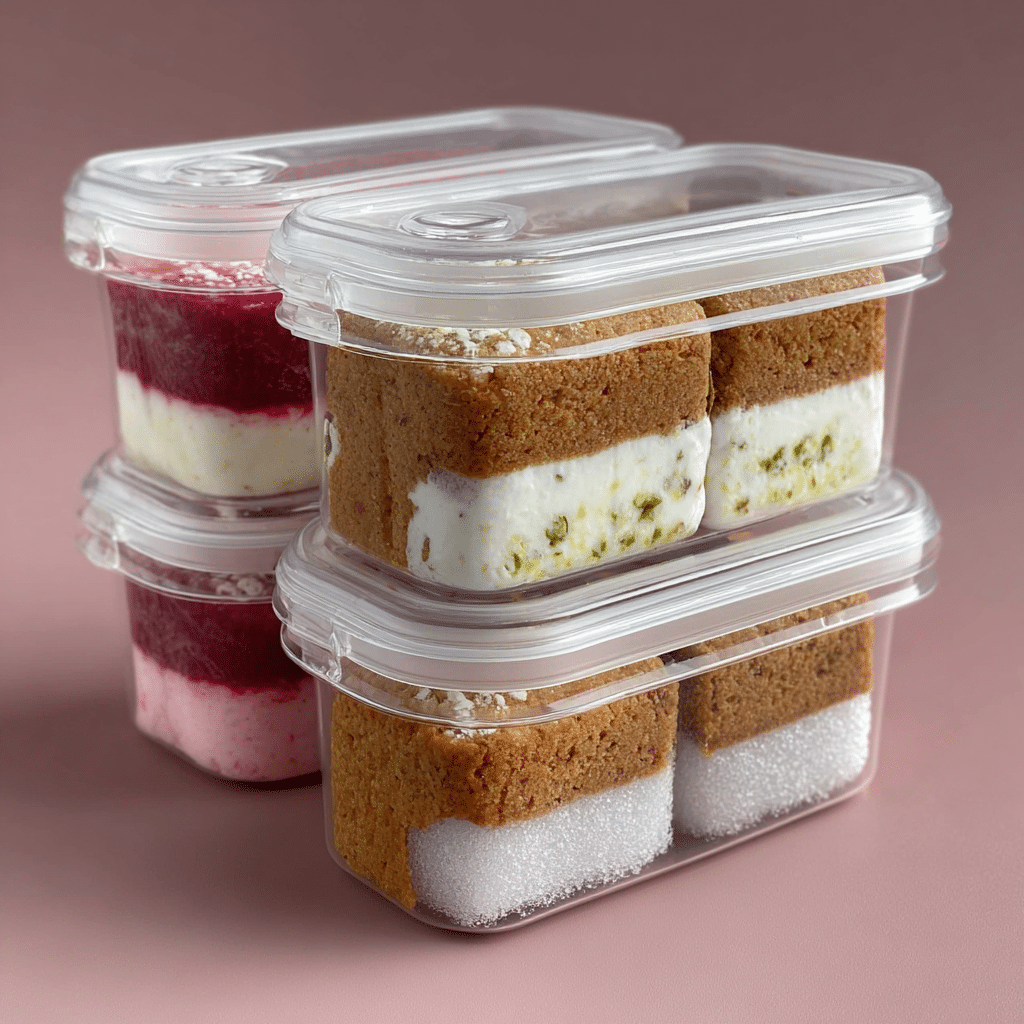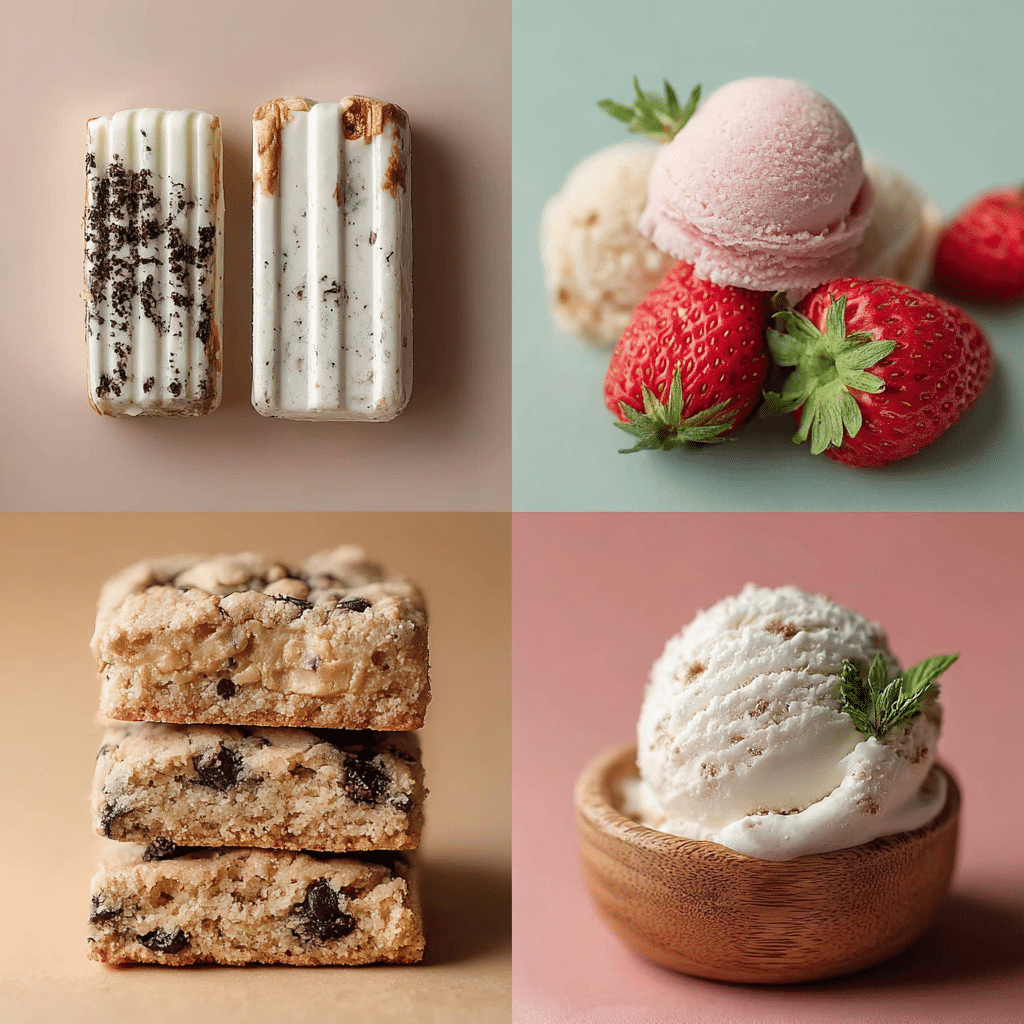Table of Contents
Why Vegan Desserts Deserve the Spotlight
Midnight cravings and dairy-free dreams
I didn’t grow up eating vegan desserts. I grew up with boxed brownie mix, ice cream sundaes with whipped cream from a can, and those fluorescent-frosted cupcakes from the grocery store. But everything changed the night I stood in my Portland kitchen in pajama pants, trying to satisfy a sweet craving with nothing but a half-empty pantry, a soft avocado, and a very judgmental cat.
I wasn’t thinking about health, labels, or trending hashtags. I just wanted dessert—something cold, creamy, and sweet. That late-night improvisation turned into one of the first vegan desserts I ever made: a mashed avocado chocolate mousse with maple syrup and cocoa powder. It wasn’t perfect, but it was rich, silky, and shockingly satisfying. Miso, my cat, looked impressed. Or maybe confused.
I’ve spent countless nights testing easy recipes that skip the oven but keep all the fun. From classic Icebox Cake to chewy Peanut Butter Oat Bars, every recipe is designed to be fuss-free and satisfying.

That moment cracked something open. Suddenly, I was experimenting—chia puddings, no-bake cookie dough, whipped coconut cream. I discovered that vegan desserts weren’t some compromise or downgrade. Done right, they’re decadent, creative, and wildly flexible. They became more than substitutions—they became staples.
Now I look back and wonder why I ever thought butter and eggs were mandatory. The truth is, plant-based desserts can be just as indulgent and varied as traditional ones, especially when you learn a few tricks and have the right ingredients on hand. If you’ve already tried our Vegan Strawberry Cream Bars or swooned over our No-Bake Chocolate Tart, you know what I mean.
Here are a few easy vegan dessert ideas you can try:
| Dessert | Main Flavor |
|---|---|
| Vegan Strawberry Cream Bars | Strawberry & Cream |
| No-Bake Chocolate Tart | Rich Chocolate |
| Peanut Butter Oat Bars | Peanut Butter |
| Lemon Cheesecake Cups | Lemon & Cream |
They’re easy to adapt and customize too. For example, you can switch almond butter for peanut butter, use gluten-free cookies in crusts, or swap fruits based on the season. For practical ideas, The Kitchn has lots of no-bake tips you can trust.
And for balanced eating advice, Harvard T.H. Chan School of Public Health explains plant-based diets in detail so you can feel good about every choice.
They’re easy to adapt and customize too. For example, you can switch almond butter for peanut butter, use gluten-free cookies in crusts, or swap fruits based on the season. For practical ideas, The Kitchn has lots of no-bake tips you can trust.
And for balanced eating advice, Harvard T.H. Chan School of Public Health explains plant-based diets in detail so you can feel good about every choice.
PrintVegan Desserts: The Ultimate Guide to Plant-Based Sweets
This 3-ingredient vegan chocolate mousse is silky, rich, and shockingly easy to make. Perfect for weeknights, dinner parties, or midnight cravings.
- Prep Time: 5 minutes
- Cook Time: 0 minutes
- Total Time: 5 minutes
- Yield: 2 servings 1x
- Category: Dessert
- Method: No-Bake
- Cuisine: American
- Diet: Vegan
Ingredients
1 ripe avocado (peeled and pitted)
1/4 cup unsweetened cocoa powder
1/4 cup maple syrup (or more to taste)
Instructions
1. In a food processor or blender, combine the avocado, cocoa powder, and maple syrup.
2. Blend until completely smooth and creamy, scraping down sides as needed.
3. Taste and add more maple syrup for sweetness, if desired.
4. Spoon into serving cups and refrigerate for 30 minutes before serving.
5. Top with coconut whipped cream, berries, or chopped nuts if desired.
Notes
Use a very ripe avocado for the smoothest texture.
Can be made up to 2 days in advance—store covered in the fridge.
Optional add-ins: 1 tsp vanilla extract, pinch of sea salt, or a dash of espresso powder for depth.
Nutrition
- Serving Size: 1 cup
- Calories: 190
- Sugar: 14g
- Sodium: 5mg
- Fat: 10g
- Saturated Fat: 2g
- Unsaturated Fat: 8g
- Trans Fat: 0g
- Carbohydrates: 24g
- Fiber: 6g
- Protein: 2g
- Cholesterol: 0mg
This guide is for anyone who wants to dive deeper into the world of vegan desserts—whether you’re avoiding dairy, baking for someone who is, or just want to explore how much joy you can create with plants, nuts, and natural sweetness.
Ingredients That Define Vegan Desserts
From cashew cream to aquafaba: Dairy-free staples
What sets vegan desserts apart is not the lack of traditional ingredients—it’s the abundance of creative substitutes that still deliver on taste and texture. At first, it might seem strange to whip up a frosting without butter or make meringue without egg whites. But once you get to know the stars of the vegan pantry, you’ll realize you’re not giving anything up—you’re just working with a different kind of magic.
Cashew cream is a go-to for silky fillings, frostings, and cheesecake-style bases. Coconut cream adds richness to mousses and whipped toppings (you can see it shine in our Vegan Chocolate Tart). For structure and fluff, aquafaba (the liquid from canned chickpeas) acts as a shockingly good egg white replacement—it’s how we get those pillowy meringues and marshmallow-textured layers.
Flaxseed and chia seeds often replace eggs in baked vegan desserts, helping bind doughs and batters without altering the flavor. Maple syrup, dates, and coconut sugar step in for refined sugar with deeper, richer sweetness. Oats, almond flour, and gluten-free blends are common in crusts and cookies, giving a satisfying bite without dairy or eggs.

Once you learn these swaps, the world of vegan desserts opens up fast. You don’t need a specialty store—just a stocked pantry and a little imagination.
Common misconceptions and hidden non-vegan traps
A lot of people think vegan desserts are automatically healthier or always low in sugar—but that’s not a rule. You can make decadent, chocolate-dripping, ultra-rich vegan treats, or keep things light and fruit-forward—it’s all about your approach.
One thing to watch: ingredients that sound vegan but aren’t. Some white sugars are processed with bone char. Gelatin (found in many store-bought puddings and gummies) is animal-based. Some sprinkles and red colorings use carmine, which comes from beetles. That’s why homemade or clearly labeled products are usually the safest choice.
In our Gluten-Free Vegan Baking Basics post, we break down ingredient labels and pantry swaps so you can bake confidently without second-guessing.
Serving, Storage & No-Melt Tips
How to transport vegan desserts without melting
If you’ve ever watched a coconut cream tart collapse in a hot car, you know that transporting vegan desserts can be a challenge—especially the no-bake kind. But the solution isn’t complicated—it’s strategic.

First, know your dessert’s structure. Bars with solid crusts (like our Vegan Strawberry Cream Bars) travel better than mousse-filled cups. Always chill the dessert fully before transport—overnight is best. Then, freeze it for 20–30 minutes before packing so it holds firm even outside the fridge.
Use an insulated bag or a small cooler with ice packs. For layered or piped desserts, insert toothpicks and tent with foil or parchment to protect the surface. If you’re traveling far, stick with sturdier treats like date balls, peanut butter cookies, or baked loaf cakes.
Check out the guide on Transporting Vegan Desserts Without Melting for step-by-step tips that work in every season, not just summer.
Fridge, freezer, or table? Best ways to keep it fresh
Storage plays a big role in texture and flavor. Many vegan desserts—especially those made with nut-based creams or aquafaba—are best chilled and eaten within a few days. But others, like cookies or baked brownies, do fine at room temp.
Fridge-stored options include cashew cheesecakes, chia puddings, and anything coconut-based. These should be kept airtight to avoid absorbing odors or drying out. Freezer-safe desserts include most no-bake bars, fudge bites, and layered cakes. For easy grab-and-go servings, freeze individual slices wrapped in parchment.
Room-temperature desserts? Go for sturdy ones like oatmeal cookies, banana bread, or dense brownies. They’re less sensitive to temperature swings and great for gifting or travel.
Whether you’re storing leftovers or planning a picnic, keeping vegan desserts fresh comes down to preparation and good containers. Trust me—nothing ruins a perfect slice like freezer burn or fridge funk.
Finding & Buying Vegan Sweets That Actually Taste Good
What vegan desserts can I buy in stores?
The good news? You don’t have to make everything from scratch. These days, vegan desserts are everywhere—from the freezer section to your neighborhood bakery. But not all of them deliver on both taste and ingredients.
Some of the best store-bought options include coconut milk ice cream, almond-based chocolate truffles, vegan cheesecake slices, and oat milk-based frozen novelties. Major brands like So Delicious, Daiya, and even Ben & Jerry’s now offer plant-based lines. But always check the label—some “non-dairy” options still include hidden animal-derived ingredients like gelatin or confectioner’s glaze.
Want a quick list of reliable finds? We rounded up our favorites in the Vegan Dessert Brands We Trust guide—including ones that surprise even non-vegans. Bonus: Some of these are available on Instacart or Amazon for next-day cravings.
If you’re more into the bakery scene, look for labels like “plant-based” or “certified vegan.” Many modern bakeries now offer cupcakes, brownies, and even cream puffs that are completely dairy- and egg-free—but you’ll want to ask about cross-contamination if you’re serving someone with allergies.
Are vegan desserts actually healthier? What to look for
Here’s the truth: vegan desserts can be healthier—but not always. Just because something is made without butter or eggs doesn’t mean it’s low in sugar or fat. A coconut milk brownie might still pack 20g of sugar and 15g of fat, even if it’s technically “vegan.”
What can make vegan options healthier is the use of whole-food ingredients: nuts, dates, oats, fruit purées. Look for short ingredient lists, natural sweeteners like maple syrup or agave, and flours that add fiber (like almond or oat).

In homemade recipes—like our 5-Minute Vegan Mug Cake or Chia Jam Bars—you have full control over what goes in. You can cut sugar, skip oil, or add in flax, chia, or protein powder.
The key is to treat vegan desserts like any treat: enjoy them mindfully, tweak where it makes sense, and don’t be afraid to indulge. Plant-based doesn’t mean bland—it means options.
For visual inspiration and more culinary ideas, follow us on Pinterest and Medium. You’ll discover stunning presentations and helpful tips to perfect your dishes!
FAQs About Vegan Desserts
How to transport vegan desserts without melting?
To prevent melting, fully chill your vegan dessert overnight, then freeze it briefly before packing. Use an insulated cooler bag with ice packs and place foil or parchment over decorated tops to avoid smudging. Solid treats like bars or cookies are the most travel-friendly options.
What sweets do vegans eat?
Vegans enjoy a wide variety of sweets: chocolate made without milk solids, fruit-based popsicles, date balls, no-bake bars, coconut-based ice cream, chia puddings, and baked goods made without eggs or dairy. There are many delicious store-bought and homemade vegan desserts that satisfy every sweet tooth.
Are vegan desserts healthier?
Vegan desserts can be healthier, especially when made with whole-food ingredients like nuts, oats, dates, and fruit. However, “vegan” doesn’t automatically mean low-calorie or sugar-free. Always check ingredients—some vegan products may still contain refined sugars or processed oils.
Do vegan desserts have more sugar?
Not necessarily. Some store-bought vegan desserts use more sugar to make up for lack of dairy richness, but homemade options can easily be adjusted. Many recipes use maple syrup, dates, or coconut sugar, which offer sweetness with extra nutrients and lower glycemic impact.
What do vegans eat for dessert?
Vegans enjoy desserts like fruit crisps, dairy-free ice creams, chia puddings, and no-bake treats. They use ingredients like coconut milk, nut butters, and flax eggs to create cookies, brownies, and cakes—no dairy or eggs needed. Even classic favorites like chocolate mousse or banana ice cream can be made 100% plant-based.
Conclusion
Vegan desserts aren’t about sacrificing anything. They’re about discovering new ways to satisfy your cravings that feel just as rich and fun. Once you see how simple it is to make no-bake treats like Freezer-Friendly No-Bake Peanut Butter Oat Bars or the tropical-inspired Hawaiian No-Bake Cheesecake, you’ll wonder why you ever thought you needed the oven.
These recipes prove dessert can be easy, flexible, and completely plant-based. For thoughtful, evidence-based guidance on making plant-forward choices part of a balanced lifestyle, the Harvard T.H. Chan School of Public Health has excellent resources to help you feel good about every bite.
So grab your favorite ingredients, skip the oven, and treat yourself to something deliciously simple.

